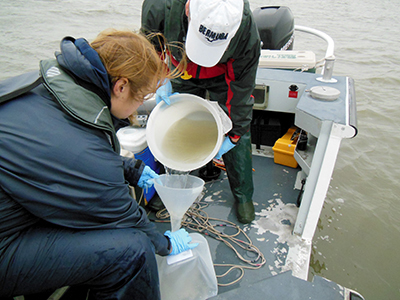Delaware • New Jersey • Pennsylvania
New York • United States of America
- Aquatic Life Designated Use Project
- Bacteria Monitoring
- Biomonitoring Program
- Chlorides Monitoring
- Contaminants of Emerging Concern
- Delaware Estuary Water Quality Monitoring Program
- Dissolved Oxygen and Nutrients
- Modeling
- Other Monitoring (e.g., Toxicity, Fish Tissue, Metals)
- PCBs and PMPs
- Special Protection Waters (SPW)
- Water Resource Data Sets
 |
| DRBC staff collect a water sample from the Delaware Estuary to monitor for toxic pollutants. Photo by DRBC. |
Toxic chemical compounds can have adverse effects on aquatic life and human health as a result of both short-term (acute) and long-term (chronic) exposure.
These pollutants include metals such as copper, aluminum, lead and mercury, as well as a number of chlorinated organic compounds.
• DRBC Water Quality Regulations (pdf)
• DRBC Toxics Advisory Committee
The DRBC conducts periodic monitoring of ambient water toxicity as part of its program to control toxic substances in the Delaware Estuary.
In fact, its ambient toxicity monitoring program is the only on-going program that tests for water column toxicity in the Delaware Estuary.
Monitoring toxicity helps assess compliance with regulatory standards, which state that no adverse effects should be observed in toxicity tests with undiluted ambient water.
Most effluent dischargers to the Delaware River are currently monitoring for chronic whole effluent toxicity (WET).
WET is the total effect of wastewater, ambient water and/or stormwater on aquatic organisms (e.g., fish and macroinvertebrates). It allows for the assessment of toxicity as a whole, rather than from a single chemical or constituent.
Typically performed in a laboratory, WET can be acute (short-term effects) or chronic (long-term effects).
WET tests are extensively used to measure the combined effects of wastewaters from industrial and municipal facilities on organisms' ability to survive, grow and reproduce.
WET testing implements national, basin states and DRBC narrative water quality policies of no toxics in toxic amounts.
The DRBC and Pennsylvania have adopted numeric water quality criteria to protect against acute effects on aquatic life (0.3 Toxic Units acute) and chronic effects (1.0 Toxic Units chronic) from toxic pollutants such as pesticides, dioxins/furans and polycyclic aromatic hydrocarbons (PAHs).
DRBC Monitoring Reports
- Enhanced Monitoring for Toxics and Emerging Contaminants in Delaware Estuary Tributaries (pdf; April 2025)
- Monitoring in Tributaries of the Delaware River for Ambient Toxicity: 2016 Narrative Report (pdf; May 2017)
- Monitoring in Tributaries of the Delaware River for Ambient Toxicity: 2015 Narrative Report (pdf; August 2016)
- Monitoring the Tidal Delaware River for Ambient Toxicity: 2013 and 2014 Narrative Report (pdf; August 2016)
- Monitoring the Tidal Delaware River for Ambient Toxicity: 2012 Narrative Report (pdf; April 2013)
DRBC Presentations
- Toxicity Testing in Ambient Water Quality Assessment (pdf; DRBC presentation given at the January 2013 Partnership for the Delaware Estuary Science Summit)
- Update on Monitoring Ambient Aquatic Toxicity (pdf; presentation given at Apr. 2010 Meeting of the DRBC Toxics Advisory Committee's Ambient Toxicity Workgroup)
Informational Links/Papers
- Society of Environmental Toxicology and Chemistry Technical Issue Paper (SETACTIP): Whole Effluent Toxicity Testing (pdf)
- U.S. Environmental Protection Agency: Whole Effluent Toxicity
- MacGillivray, AR, DE Russell, SS Brown, TJ Fikslin, R Greene, RA Hoke , C Nally and L O'Donnell. 2011. Monitoring the Tidal Delaware River for Ambient Toxicity. Integr. Environ. Assess. Manag.: 7 (3) 466-477.
- U.S. EPA Listing of Toxic and Priority Pollutants
DRBC Resolutions related to Toxic Pollutants
-
Resolution 2010-13: Updates DRBC's Water Quality Criteria for Toxic Pollutants for the Delaware Estuary and Bay (pdf; Dec. 2010)
- Response to Comments Document on Toxic Pollutants Update Proposal (pdf; Nov. 2010)
- Water Quality Criteria for Toxic Pollutants for Zones 2-6 of the Delaware Estuary: Basis and Background Document (pdf; Jul. 2010, revised Dec. 2010)
- Response to Comments Document on Toxic Pollutants Update Proposal (pdf; Nov. 2010)
- Resolution 2000-13: Resolution to Control Estuary Toxics (pdf; Jul. 2000)
-
Resolution 2000-4: Relating to the Control of Toxic Pollutants from Point Sources Discharging to the Delaware River Estuary (pdf; Jan. 2000)
Copyright © Delaware River Basin Commission,
P.O. Box 7360, West Trenton, NJ 08628-0360
Phone (609)883-9500; Fax (609)883-9522
Thanks to NJ for hosting the DRBC website